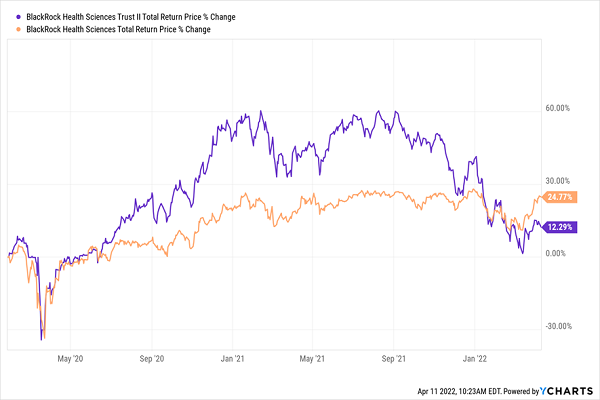There’s nothing we closed-end fund investors love more than finding a smartly run fund in an unfairly beaten-down sector. This hands us a nice discount (of course!), plus a much bigger dividend, because yields and prices move in opposite directions.
In fact, with CEFs, we’re actually getting a “double discount”: one from the depressed sector and one from the CEF’s discount to net asset value (NAV, or the value of the stocks in its portfolio). This indicator only exists with CEFs, and we’ll cover four with particularly attractive discounts to NAV in a second.
Plus, CEFs already boast yields that triple (or more) those of regular stocks, so deep-discounted CEFs give you an income stream that’s bigger still.
Health Care’s Slump Can’t Last. Let’s Tap it for (Monthly) Dividends Up to 9.1%
These days, health care is hands-down the most wrongly trashed corner of the market.
Think about it: COVID-19 has thrown the need for health care into sharp relief. And the aging of America — a trend that was overshadowed during the pandemic — isn’t going anywhere. No wonder U.S. health care spending is forecast to jump from $4.2 trillion annually in 2021 to $6.2 trillion by 2028, according to Statista.
With that in mind, the sector’s drop in 2022, as shown below by the performance of the iShares Biotechnology ETF (Nasdaq: IBB), is a terrific opportunity for us to fish for big payouts, especially since IBB has outrun the S&P 500 over the long haul:
Biotech’s Recent Lag Opens Our Buy Window

But CEF fans that we are, we’ll take a pass on IBB and its microscopic 0.45% yield.
Instead, we’re going to look at four health care-focused CEFs. Two come from the world’s biggest investment manager, and two are run by an upstart with unmatched expertise: It employs an all-star team of medical researchers and financial pros to find companies with the best odds of developing breakthrough treatments.
2 Bargain-Priced BlackRock Health Care CEFs Yielding Up to 9%
BlackRock needs no introduction: The mega-fund manager has over $10 trillion of assets in its care and two health care CEFs worth a look: the BlackRock Health Sciences Trust (NYSE: BME), which yields 5.6%, and the 9%-paying BlackRock Health Sciences II Trust (NYSE: BMEZ).
BlackRock CEFs Deliver Most of Their Gains in Dividend Cash
Since BMEZ’s IPO in 2020, it has delivered a total return similar to that of IBB, but with a much bigger share of that return in cash. BME has performed better, with the trade-off being a smaller, but still generous, 5.6% yield. It’s worth noting, too, that both funds pay dividends monthly, so their payouts nicely line up with your bills.
What about their portfolios? BME’s top holdings are conservative and include insurer UnitedHealth Group Inc. (NYSE: UNH), diagnostic-equipment maker Thermo Fisher Scientific Inc. (NYSE: TMO) and drug maker Abbott Laboratories (NYSE: ABT).
BMEZ, for its part, counts cancer-treatment producer Seagen Inc. (Nasdaq: SGEN), vision-care firm Alcon AG (NYSE: ALC) and Masimo Corp. (Nasdaq: MASI), a diversified maker of patient-monitoring systems, among its top investments.
Note that BMEZ’s picks are all smaller firms with growth potential — but also a bit more risk. The market is compensating you for those risks, though, since BMEZ trades at a 13% discount to NAV, versus BME’s 1% premium.
2 Big-Yielding Health Care Picks From an Overlooked Specialist
To diversify further within health care, consider the Tekla World Healthcare Fund (NYSE: THW), with a 9.1% yield, and the Tekla Healthcare Opportunities Fund (NYSE: THQ), which yields 5.9%. THW trades at a 1.7% premium today (which, while still a premium, is well below the 52-week average premium of 4.7%).
THQ’s discount is 6.4%, which, again, is well below its 52-week average of a 2.2% markdown. Both of our Tekla funds pay monthly, too.
These discounts are largely due to people being unfamiliar with Tekla. That’s an opportunity for us, because the firm hires pharma scientists and researchers to analyze the companies it buys. Tekla’s oldest funds have outperformed IBB over the long haul, but the newer THQ (in orange below) and THW (in blue) are no stragglers, either.
Crushing the Biotech Index
This outperformance should be rewarded with big premiums, but that’s not always the case in the irrational world of CEFs!
Both CEFs focus on larger firms from across the health care ecosystem. Top holdings for THQ include UnitedHealthGroup, Johnson & Johnson (NYSE: JNJ), Thermo Fisher Scientific, Abbott Laboratories and AbbVie Inc. (NYSE: ABBV); THW has a similar composition, with UnitedHealthGroup and Thermo Fisher among its top-10 holdings, as well as Roche Holdings (OTC: RHHBY), Pfizer Inc. (NYSE: PFE) and AstraZeneca PLC (Nasdaq: AZN).
THW is the more international fund of this pair, with a quarter of its assets outside the U.S., while THQ only holds about 2% of its portfolio abroad. So a mix of both would get you a well-diversified set of holdings and a nice income stream, plus plenty of gain potential, as we can see from these funds’ histories.
To learn more about generating monthly dividends as high as 8%, click here.




